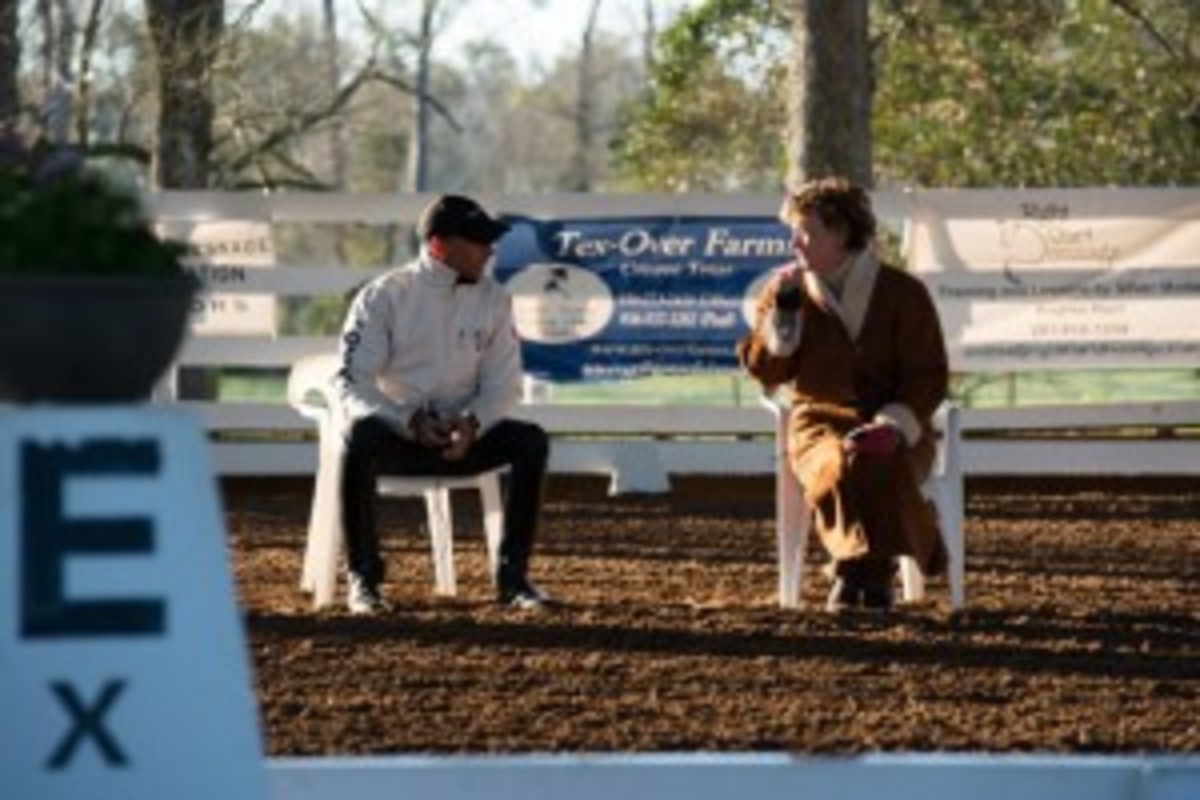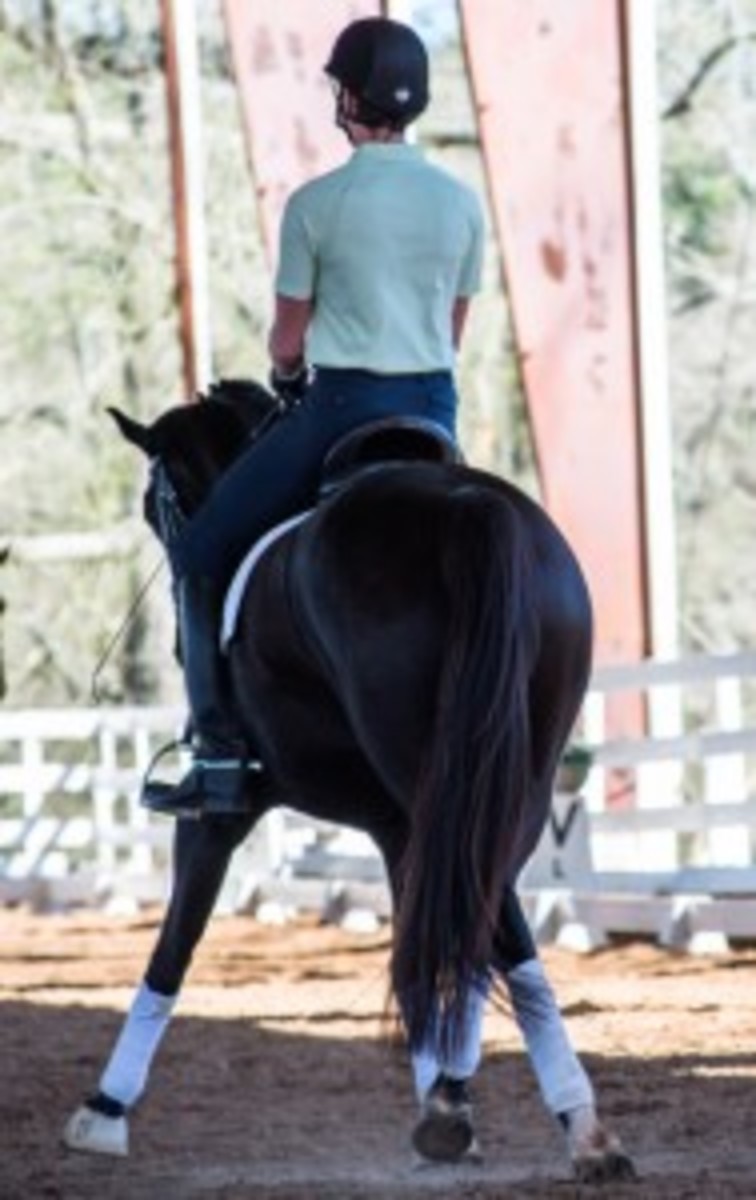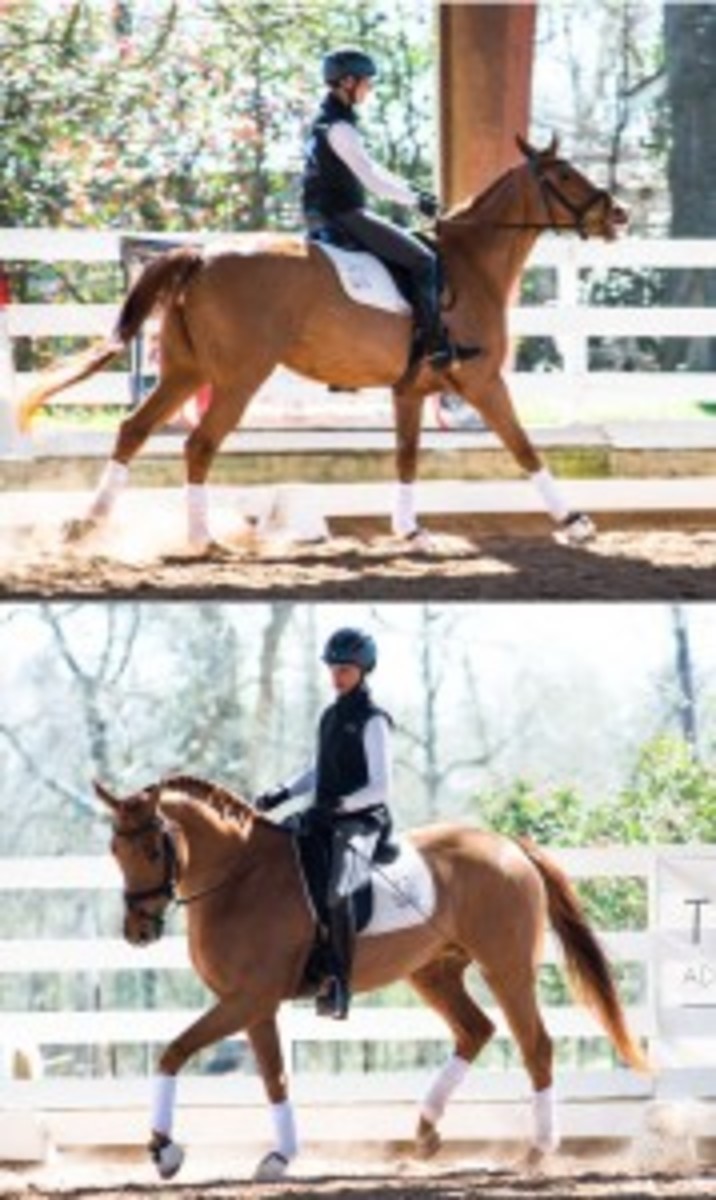Janet Foy and Steffen Peters transform riders and auditors alike.

By Sandra Adair Daugirda
On a crisp, cold Texas weekend in February, more than 250 Houston Dressage Society auditors gathered at Tex-Over Farm in eager anticipation of what they might learn from this year’s first USDF Symposium. FEI 4* Judge Janet Foy and Olympian Steffen Peters did not disappoint; they educated, encouraged and entertained. They wowed everyone as they made a dramatic difference in each of the 21 demo riders and horses. Although the? philosophies they presented may have been familiar to some, watching them in action was inspiring to all.
Janet and Steffen have a mutual commitment to correct training and partnership with the horse, as well as a passion for dressage and improving the sport in the USA. Having done clinics together for the past seven years, they have such rapport with each other that they put the riders at ease with camaraderie and a sense of humor. Janet had riders perform important movements from their level as she commented from a judge’s perspective, and then Steffen worked with them to address their issues. Without exception, they had each rider:? 1) simplify their lessons, 2) raise their standards, 3) use mistakes as training opportunities, 4) make their horse adjustable, 5) clarify his understanding of contact, and 6)? encourage his cooperation.
KEEP IT SIMPLE
“What is often seen by the rider as resistance in the horse, may actually be his lack of physical or mental understanding of the rider’s aids.”
A simple task is easy to understand, uncomplicated, fundamental and straightforward. Simplicity was the common thread throughout the work done at every level. Steffen reminded us that there are only 3 types of aids: leg, seat and rein.“Our task as a rider is to understand the aids, know how and when to use each, and then teach our horse to understand them, mentally as well as physically.” For example, to simplify the turn on the haunches, he had the riders keep turning on a slightly larger circle. By calmly addressing each component of this movement, one step at a time, each horse had the chance to learn what was expected of him now and later for canter pirouettes. For more on information on understanding the aids, go to: http://www.equisearch.com/horses_riding_training/english/dressage/eqsteffen1114/
Janet emphasized the importance of using the Pyramid of Training to keep your riding simple. (See: The Big 10, Dressage Today, August, 2012) “If you work on the basics, the movements will take care of themselves!” Janet was adamant that every rider would improve their performance by actually knowing the definitions of the terms found in the tests. (See: the glossary of judging terms).?She also stressed that riders should know the purpose, and therefore the expectations, of the level they are riding, as well as the directives for each movement within the level (all of which are found on the test sheets). To illustrate: if a horse is a 6 mover, but all the elements of the training scale were really good, the score for the movement could jump to an 8, which is then modified by the fulfillment of the directives (or lack thereof).

If a movement is complicated, it can become too much to handle for both horse or rider. Training can be simplified by breaking it down and working on smaller pieces, and then putting it all back together again. For example, when training the trot half pass, one could work on cadence in the shoulder-in, regulate the rhythm and regularity of the collected trot, and improve the bend and obedience to the inner leg through circles or leg yields. Steffen insisted, “You can’t do a thousand things during a flying change. You must have an adjustable, uphill canter with the horse straight and in front of your leg before the change. Your aids have to be obeyed without question. If you can’t do a quick canter depart on the quarter line, you can’t do changes.” Visuals can also make a tough movement easier to train. Janet had a great tip for the canter pirouette: picture your horse’s hind legs in the center of a five pointed star, and move his shoulders from tip to tip.
By keeping it simple, you will have consistency in your work, lightness in your contact, and your riding will look and feel effortless, as Axel Steiner says, “Like dancing not weight lifting.”
RAISE YOUR STANDARDS
“Every moment we are with our horse, whether on the ground or in the saddle, we are teaching them; right or wrong, we are always teaching, so don’t put things on your training blackboard that you’ll have to erase later.”
When Steffen Peters is in the warm-up ring, he asks, “Is this the feeling I want to take into the show ring? Am I in charge?” Because your horse adapts to our standards, high or low, you must? consistently teach him that the only way is the right way. Train every day for a good marching walk, a cadenced trot, an uphill canter. When something is not quite right, don’t accept it. Quickly make a correction and do it again, so the lesson is clear. If the horse goes against the bit in a transition, redo it. If he runs off like a race horse, yanking on the reins, stop him. Say, “No, sir!” Don’t punish him, teach him something!
Nowhere is this concept more important than in the horse’s response to the aids. Say you lightly close your calf for the horse to go forward and nothing happens. Immediately add more leg or spur, if necessary, until you get a true reaction. Then try again with a light calf, and repeat the process until they learn to respond to the invisible aids we desire. Don’t worry if they overreact as even a bad reaction is better than no reaction. Steffen encouraged riders not to struggle with the horse by constantly kicking, but to just remind him when necessary. “The most important part of your body is your brain!? He’s stronger, but you’re smarter.”
Don’t be happy with even a 7 or 8. If you go for more pizazz in the trot and the horse canters, it’s ok, go big in the canter. “If you don’t test your horse, your horse will test you.” Make a difference, help him learn. As Janet likes to say, “Why not a ’10’?”? Don’t tell yourself less quality is ok for now because your horse is young or only at Training Level.? Always strive to up-level. In the show ring, high standards mean not only quality work but accuracy as well.

Janet has seen everything from 24-meter ovals instead of 20-meter circles and riders who don’t seem to know where a movement begins or ends, to tempis and zig zags not centered over X. “Riders lose so many stupid points from careless corners, sloppy figures, messy transitions and crooked positions.” (For tips from Janet on maximizing show points, go to this link.?She urges riders to watch videos of great rides and implant that quality in their mind. Then come down centerline sitting tall, shoulders back, with a proud look that says, “Here I am!”
Raising your standards is another step in achieving the ultimate, harmonious ride where even your grandmother comments, “That looked so easy, why do you need more lessons?”
CLARIFY CONTACT
“Contact is the most misunderstood concept for both the horse and rider.”
Steffen was adamant about improving contact. He said that by 4 to 6 weeks under saddle, a 3 year old needs to be engaging his hind end and accepting the bit with a consistent contact and frame. He must learn to carry himself, and respect this job description for his muscles early on. This will help him to stay supple in his topline and more through from the very beginning of his work. “Not only does a horse not get better at contact as he gets older, some will spend their lives fighting the bit.” Janet pointed out that the stretch circle in Training Level is meant to test the horse’s true understanding of contact. “Judges want to see the horse stretching out and down, evenly into both reins as those are lengthened, not speeding up, staying in the contact, with his nose between his shoulder and his knee.”
Every day, guide your horse into the frame that is correct for him, one that uses his muscles. Steffen instructed,”Each horse is unique. If he wants to go low, keep him up, and vice versa.” Your reins should be equal, holding about 3 to 5 pounds of weight. Lightness refers to the elevation of the shoulders, not having little weight in the reins. “If a horse is fussy in the contact, you can be sure it is 100% mental, so you must patiently but consistently ask for his cooperation. A light tap with your whip will encourage more engagement, and thus more contact. If he is leaning on your reins, you must create a reason for him to let go. Two or three taps with your whip say, ‘This isn’t ok. I’m in charge. You must cooperate.'”
Janet gave us a great visual of contact. “Supple tension in the muscles of the back are like a well-flowing freeway carrying the energy created by the hind end over back onto the bit. If those muscles get rigid, that freeway is now in rush hour when an accident happens!”

USE MISTAKES AS TRAINING OPPORTUNITIES
“Only repeating an exercise or movement doesn’t really teach the horse, but catching his mistakes and correcting them quickly certainly does.”
Steffen encouraged the riders to not only try to avoid problems with their horse, but to relish them. While working on the collected canter, one rider kept kicking her horse to keep him from breaking into the trot. When Steffen had her stop struggling to maintain the canter, and immediately re-ask for it when he trotted, her horse was able to figure out what she wanted, and in short order. A horse’s memory is short. When something goes wrong, you only have about 5 to 8 seconds to make a correction that he will associate with the error, and that same short time span to reinforce the correct response with verbal praise or a pat on his neck. Steffen urged, “Don’t wait for a training issue to become overwhelming. Catch it early on, say, ‘This is a trouble spot, let’s work on it now.’ Don’t punish your horse, help him understand what you want.”
Janet addressed how to handle mistakes at a show by admonishing, “Train at home, not in the ring! Don’t battle or create a fight as it only makes it worse, and every sin drops your score down a bit. Try to address tension issues early in your warmup.” Although you don’t want make a big deal of disobedience, you don’t want to ignore it either. A mistake used to be an immediate 4. Now judges take one point off the score they would have given if the mistake had not occurred, so still ride for quality before and after the error. You can also make up points later in the test. If you lose your lead in the canter pirouette, change back so you can still show the required flying change. Know the beginning and end of each movement. Janet encourages, “If you blow one, make the next one great! Take advantage of non-brilliance movements like the halt or rein back, whose scores depend only on excellent training.”
Don’t miss the wonderful training opportunities mistakes provide you to clarify your aids.
MAKE YOUR HORSE ADJUSTABLE
“Because the pendulum between them is balanced, you can never have more extension than you have collection.”
From First Level to Grand Prix, the horse is asked to show increasing adjustability in the length of his stride. Janet finds that many lower level riders often show only a modest lengthening. A huge extended canter can be unsettling even for a seasoned pro. She coaxes, “Get in touch with your inner eventing self!” Every horse can go, it’s bringing him back in a timely, balanced manner that can be a bit daunting. But judges score both the transition up and BACK. They also want to see a clear difference between the medium and extended gaits. Janet exclaimed, “It isn’t just ‘go big’ vs ‘go huge’! The medium is the most off the ground, whereas the extended is the most over the ground.” If you count your strides between the letters, you can be sure you have fewer in the extended. The collected gaits should have the? shortest strides of all the paces, but with nearly the same tempo. When judging the collected canter, Janet looks for a strong topline and a good separation of the hind legs, the horse staying up in shoulders with lots of suspension in an uphill balance.

As far as Steffen is concerned, “Adjustability is so important, you must test it!” He asked the riders to tweak the tempo or the length and height of the frame. He had them regulate the tempo, and go a little forward, a little back. He asked them to lengthen the canter, and then bring it back in 9 strides, then 7, then 5. The strength this work develops is an additional benefit for all horses, especially for young ones. It also improves obedience, and the quick, correct reaction to the aids. With mastery, it would allow a horse to move from the height and intensity of piaffe to the length and relaxation of the extended walk.
Ultimately, the control that adjustability provides the rider makes his horse so rideable, he can perform every movement, every moment, with the utmost accuracy and excellence.
DEVELOP COOPERATION
“If you teach your horse to understand your aids in a simple but exacting manner, letting him learn from his mistakes, then submission will evolve into cooperation, and he will become a more reliable partner.”
Throughout the weekend Janet gave comments to the riders such as inconsistent tempo, angle varying, loosing bend, medium fading and other evidence that we must raise our standards of reliability. Steffen shared that for 45 minutes daily, he expects his horse to be a respectful partner. Even in the warm-up, he works intensely for about 5 minutes, giving him jobs that address his mind and his body. “If your training is inconsistent, your horse will be unreliable. You must make a point every time something is not quite right.” If during a transition to halt, for example, your horse is obedient, but out behind and against the bit, let him know that’s not ok. Clarify your aids and repeat until you get a balanced halt, then reward him by relaxing your leg and hand. “Always teach square halts, even to young horses.”
Janet also wanted to see the riders use more invisible aids, especially in the upper level movements. She quoted Olympian and International Judge, Jennie Loristan-Clarke, “To excel at the difficult canter zig zag, your aids must be so respected that you only have to worry about the amount of bend!” Steffen concurred, “I never want to struggle. I teach my horse to offer the movements. When he’s good, I remove my leg and say, ‘Now you do it!'” For example, he never kicks a horse into piaffe, but tests him, correcting as needed. “I don’t train for a better piaffe, but for a more dependable one.” For passage, Steffen simply sinks into his heels, adds his calves and closes his thighs, using his spurs only as a momentary reminder.
“I want him to offer everything: collection, extension, transitions, straightness, even corners.”
A horse that understands what is expected of him, and offers it out of a sense of cooperation,? is a truly reliable partner, and the rider can achieve the ultimate goal in dressage: harmony.












